Title: Was This Helpful? Yes or No.
Subtitle: Design Explorations of Ethics and Agency In Social Media
Supervisor: Dr. Bonne Zabolotney
Methodology: Action Research
Abstract:
This thesis research was done as part of my Masters of Design at Emily Carr University of Art + Design, Vancouver from 2020 to 2022.
This thesis project focuses on exploring the ways in which designers can facilitate agency and ethical understanding in social media users. My research began with the investigation of how consent forms for online platforms are designed, the rules that govern them, and the amount of user information collected through these forms. At the same time, I investigated the definition of true informed consent on these platforms.
I conducted various data visualization experiments, using both simple and complex data, to learn the ways in which information design can make data understandable. Using quantitative methods and design action research, I expanded my investigations to interrogate concepts of data exhaust, inferences, and behavioral modification, with the aim to empower users to understand and control the use of their personal data.
Throughout these investigations and research projects, I understood that information design can be a useful tool to uncover ethical, political, and corporate structures which affect the privacy and agency of social media users. Uncovering these structures also assist future designers in understanding their own contributions to these spaces.
Research Questions:
1. How can designers facilitate agency and ethical understanding in social media users?
2. How can information design assist in understanding and developing transparency and ethics in informed consent?
3. Can visualizing a privacy policy statement of an online platform lead to the same engagement from users?
My studies started with a critical response on Ethics in Design, 10 Questions by Clive Dilnot. He writes about considering design’s role as serving the wider interests, of subjects, rather than the narrow interests of private profit. He argues, that incorporating ethics in design, will counter our culture and social inability, to designate the dimensions of human good beyond that of the market, bring absolute primacy of the interest of human beings in a human future and open up ways of making and remaking a sustainable world.
Meanwhile in January 2021, WhatsApp announced that it will be updating its Privacy Policy, which would allow it to share more user data with Facebook. This led to a widespread backlash from users, who immediately started fleeing to other messaging platforms, and WhatsApp had to delay the new Terms of Service by 3 months.
This led me to my first research question of ‘How can designers facilitate agency and ethical understanding in social media users?’
The research is categorized into the following 3 stages:
Research Stages
I started this research by studying online consent forms of different social media platforms. User agreements are typically ignored by people using online services, therefore users are not aware of the potential harms associated with sharing of their personal information.
I then studied the different rules and regulations that are in place to keep a check on how companies use and store user data. This was done by looking at the General Data Protection Regulation which is a regulation in EU law on data protection and privacy in the European Union and the European Economic Area General Data Protection Regulation.
I then investigated to understand what does it mean to own your data on the internet. In their journal, Ethics of Sharing, authors Felix Stalder and Wolfgang Sutzl, write about how ‘Pre-digital sharing was about exchange, but sharing with digital technologies is about exchange and distribution. Do we really have control of our data once its on the internet, or are we being tricked into the whole notion of our data being secure and still ours?
To understand Informed Consent on digital platforms, I read ‘Building Consentful Tech’ by Una Lee and Dan Toliver. The authors write about how consent on digital platforms should be:
Freely Given, Reversible, Informed, Enthusiastic and Specific
Understanding Informed Consent on Digital Platforms
This led me to my next research question:
How can information design assist in understanding and developing transparency and ethics in informed consent?
This phase of my research started by looking at Data Visualization and to do that, I read Dear Data by Giorgia Lupi and Stefanie Posavec and Envisioning Information by Edward Tufte among others. Referencing these authors led me into my first experiments in data visualization.
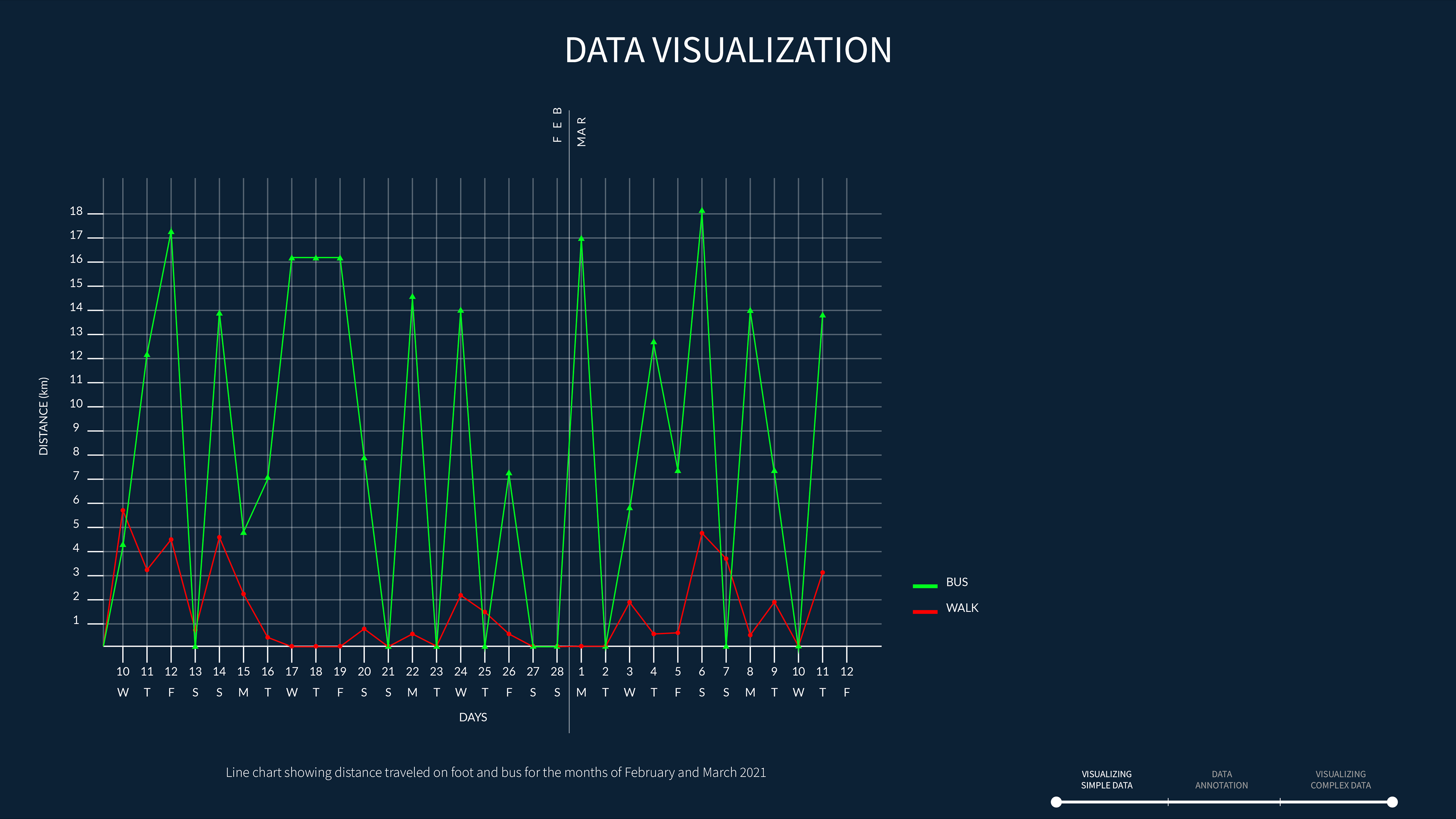
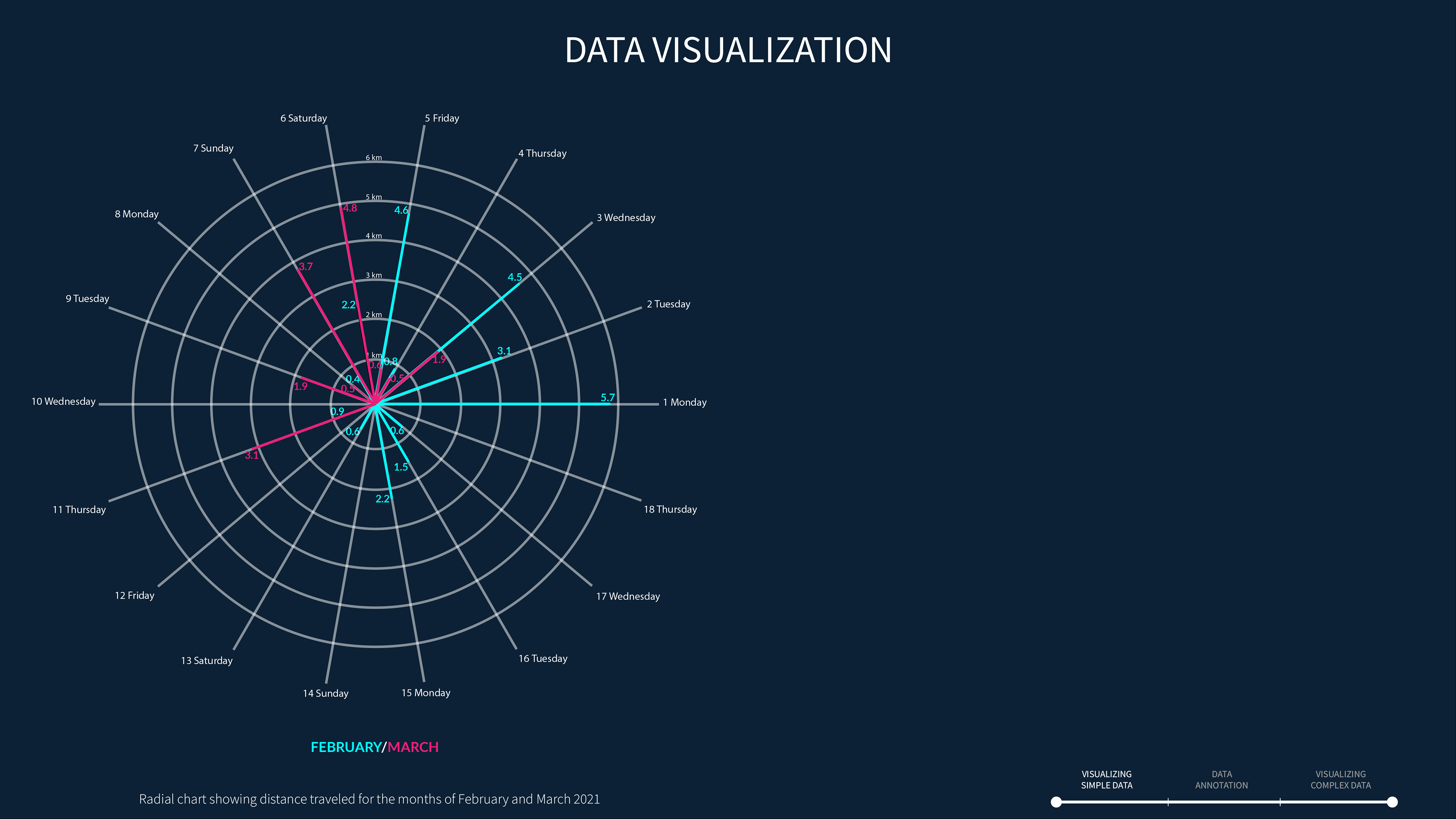
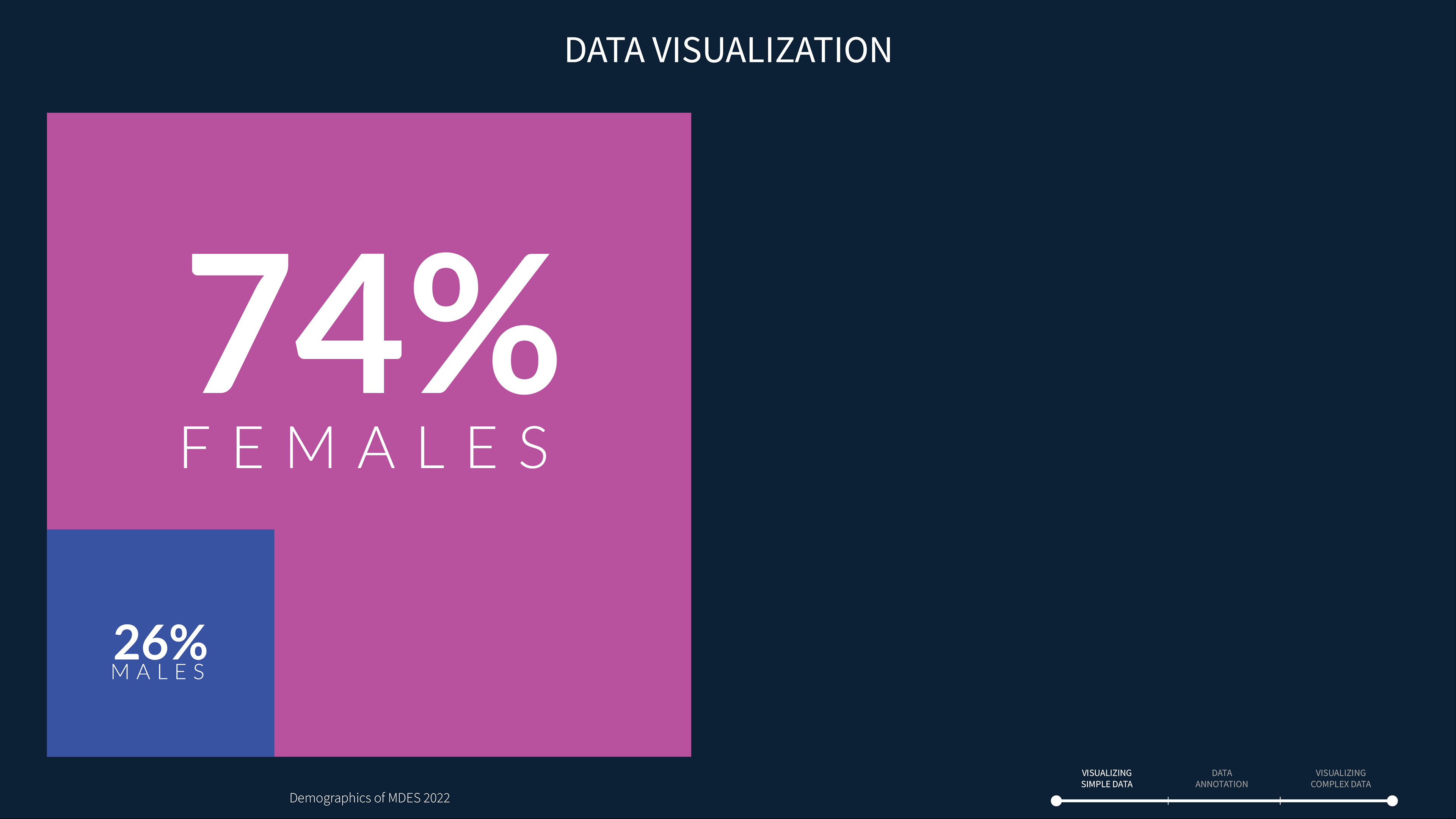
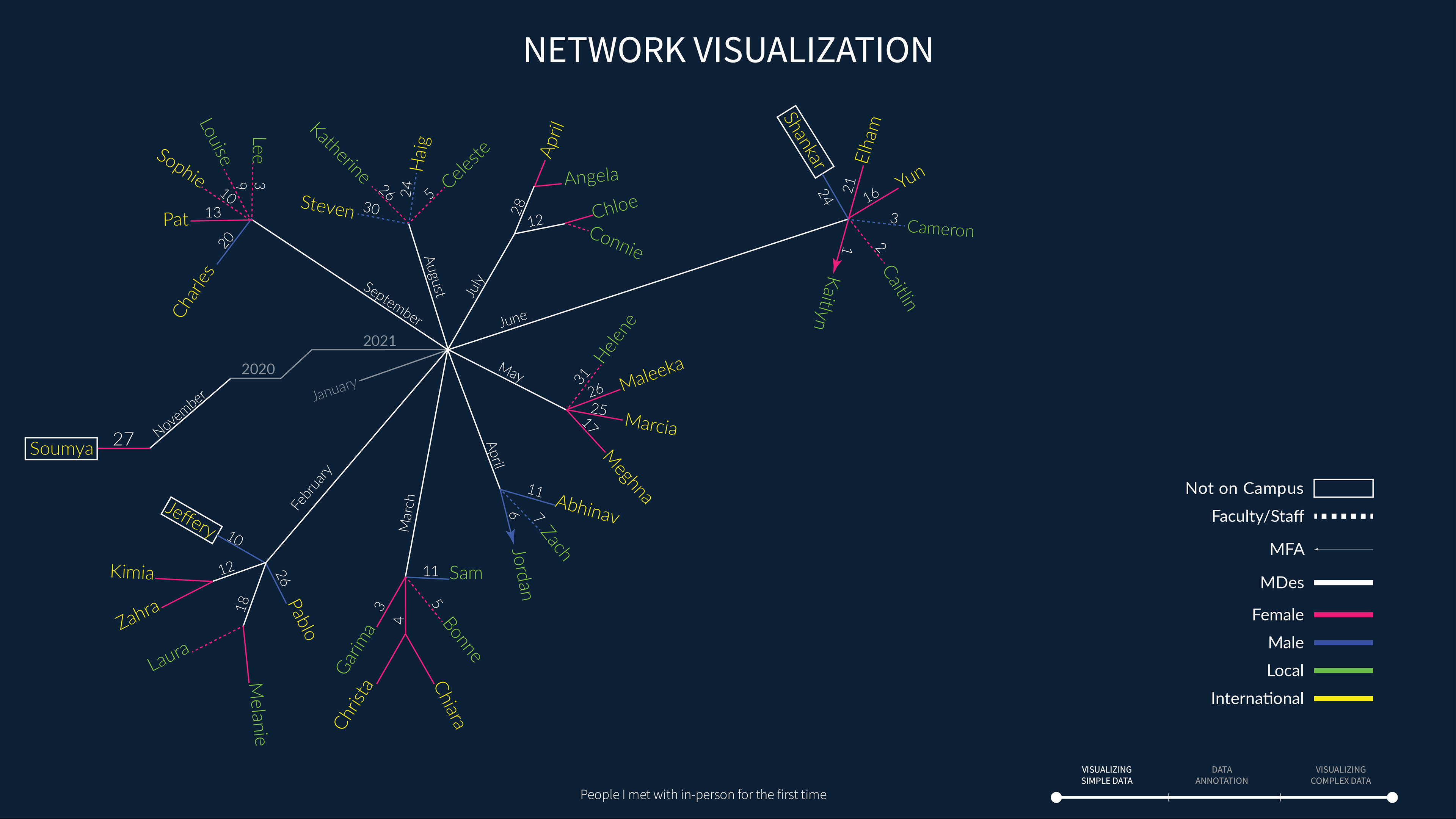
All these experiments helped me understand how data can speak volumes about people’s lives and visualizing it enables an easier way to understand it. This reflects back on what Giorgia Lupi and Stephanie Posavec write in their book Dear Data, that data is not just about numbers and percentages, but can also be presented in its lateral truths that can reveal emotions, wants, needs and the personality of the person it belongs to.
For the next phase of my research I wanted to see if visualizing complex data could lead to engagement from viewers. This led me to my first experiment in Data Annotation.
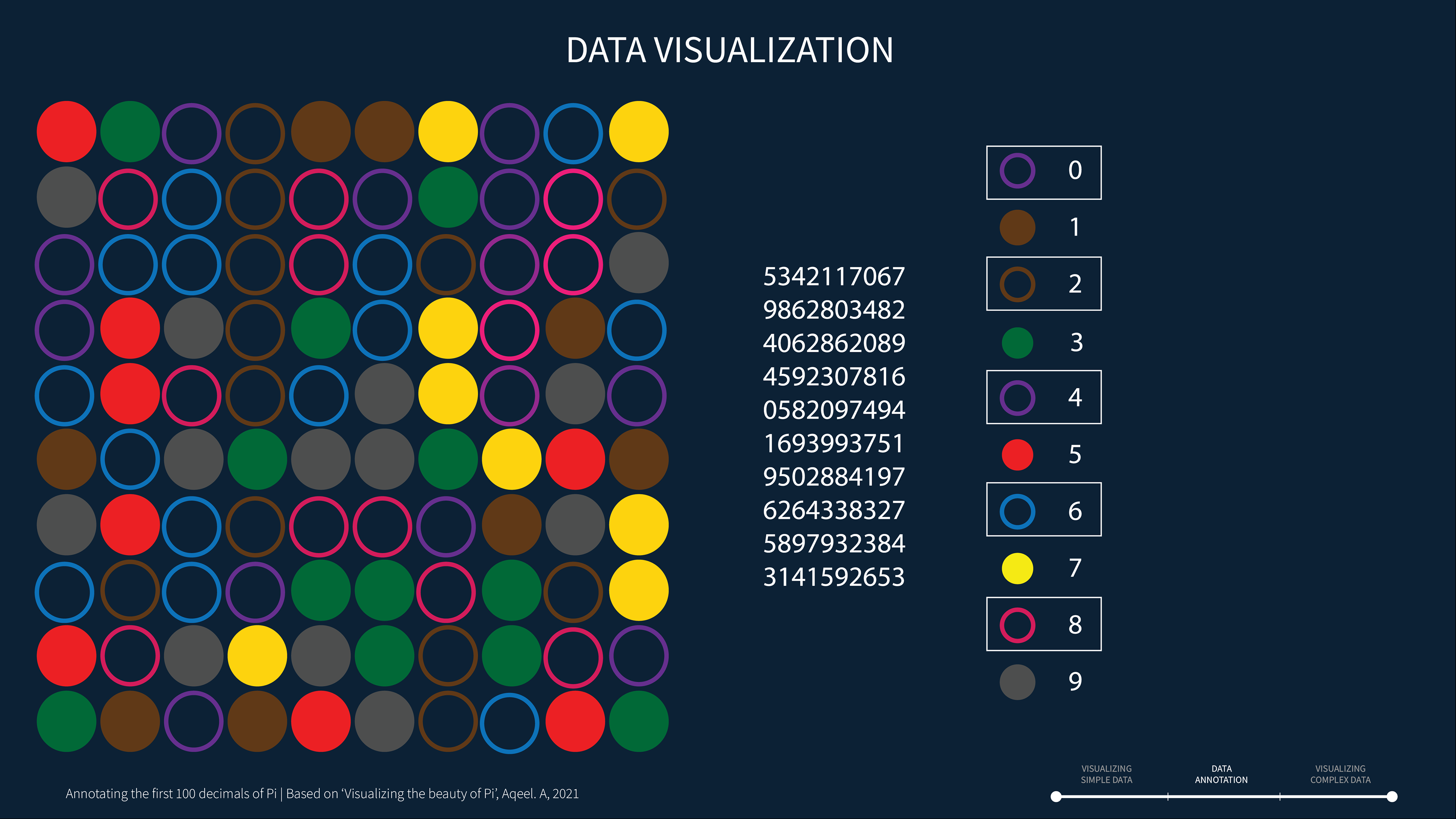
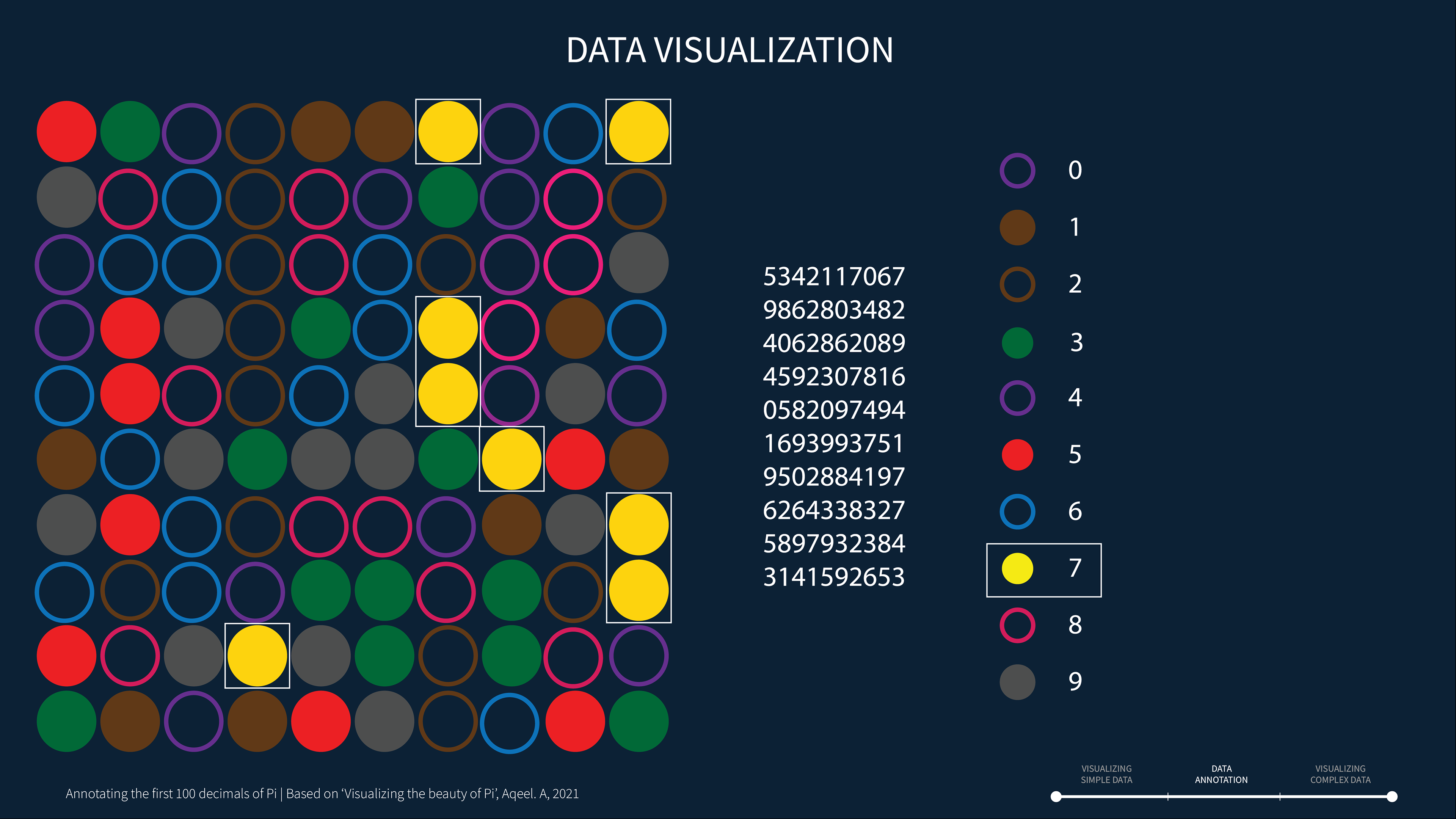
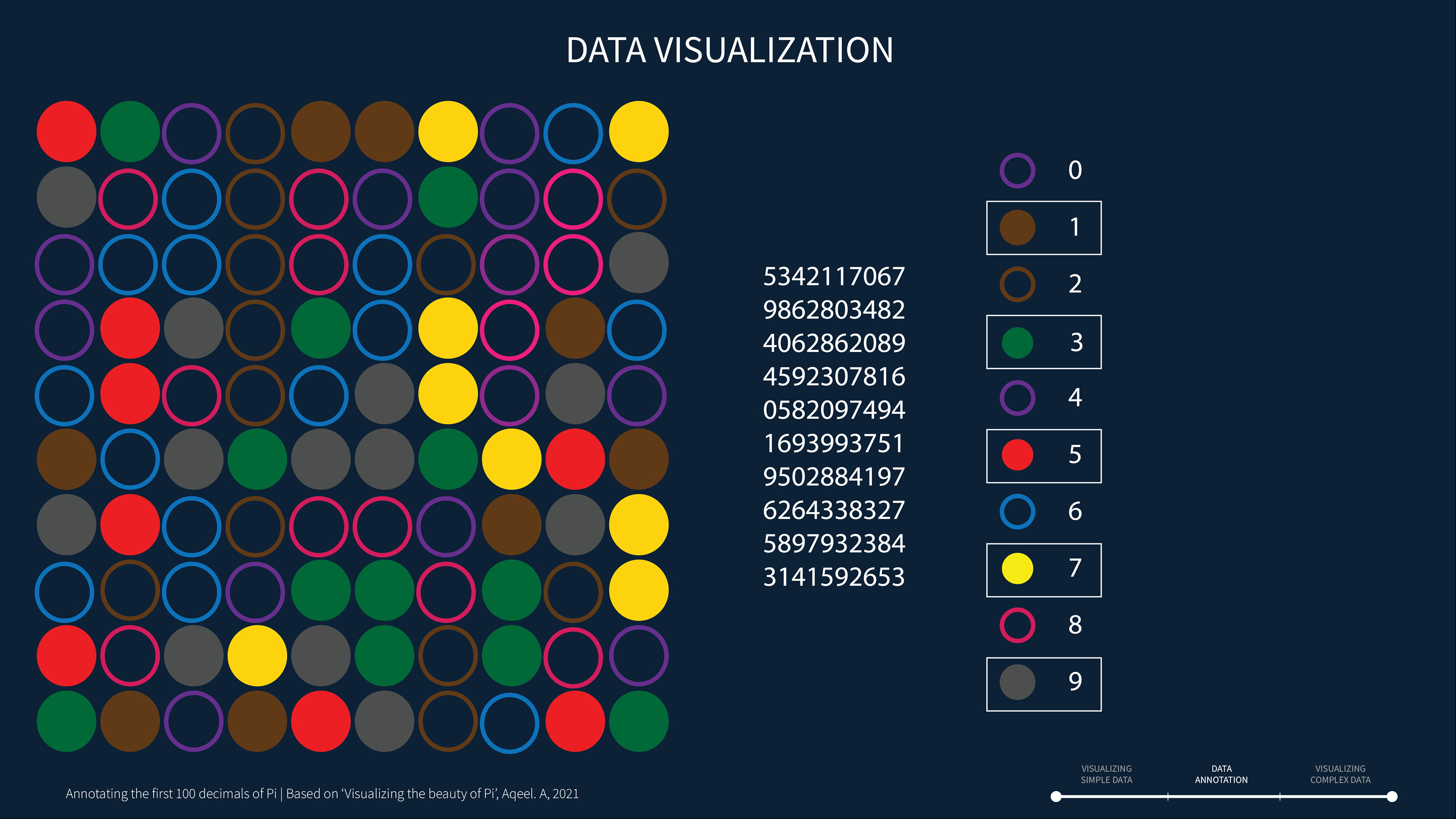
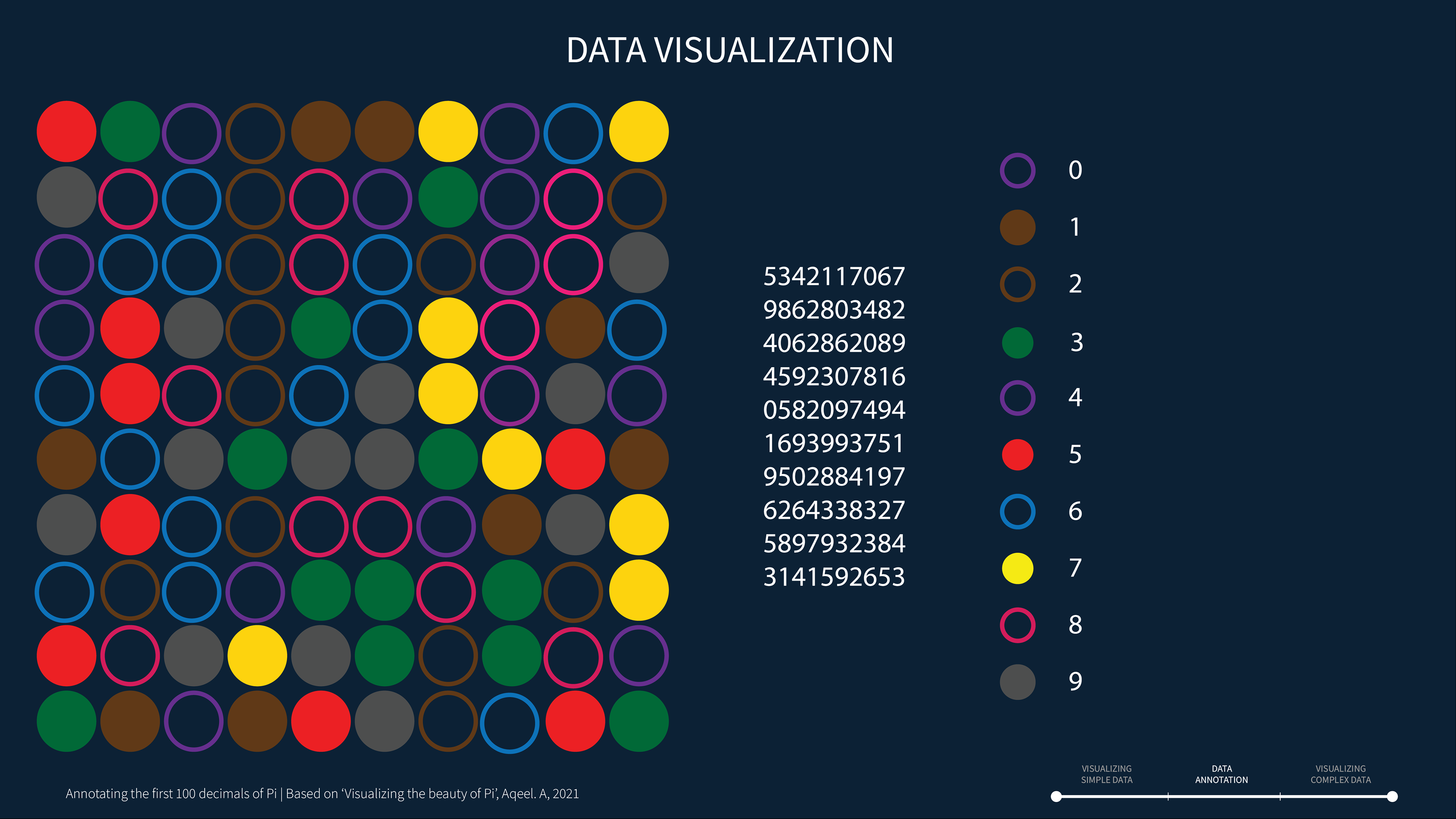
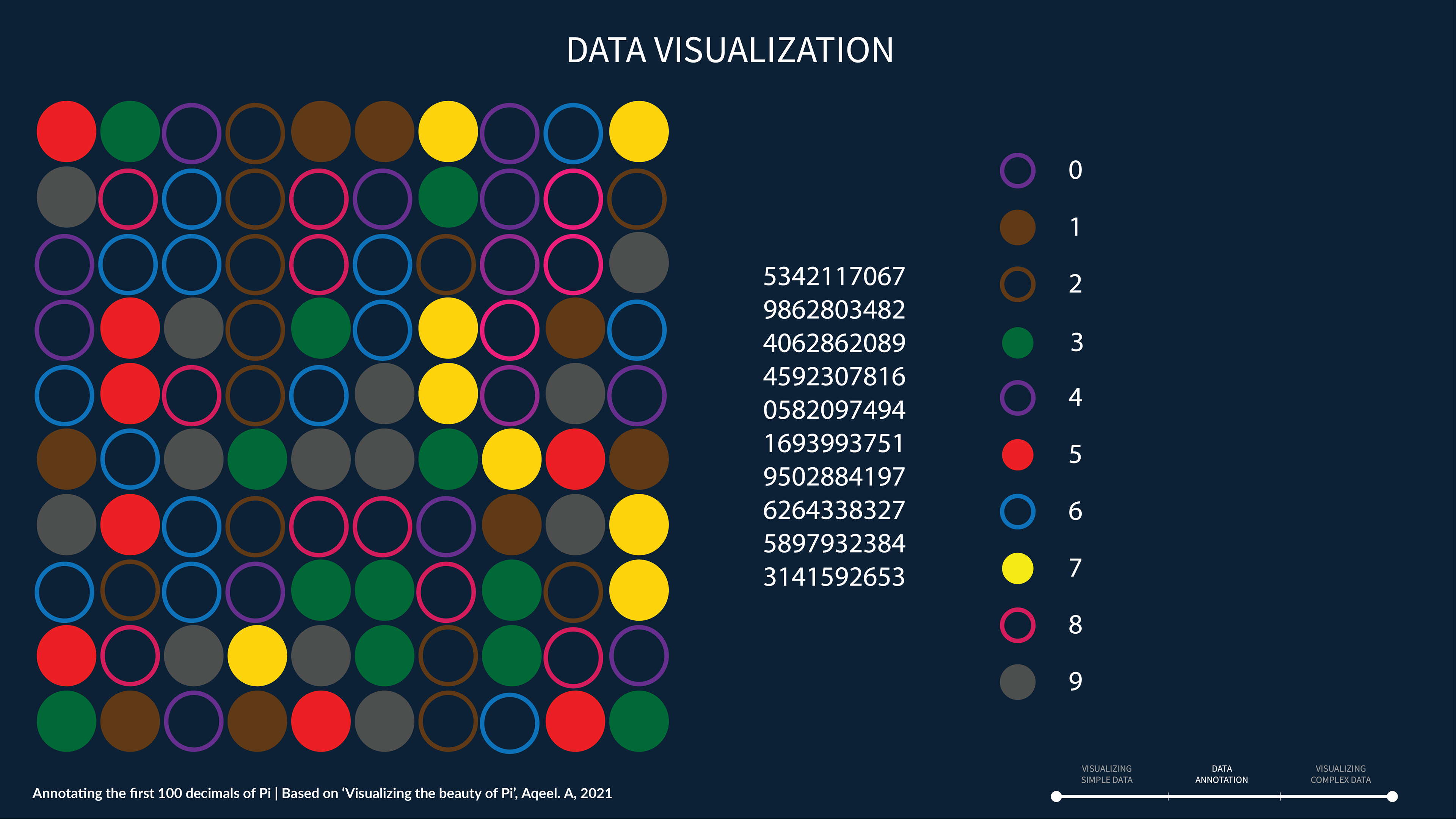
The first 100 decimals of the value of Pi were annotated using circles. All even numbers were annotated with hollow circles while solid circles were used to annotate odd numbers appearing in the series. Arranging these numbers in a grid of 10x10 interesting patterns started to emerge. For instance, the first 5 digits from the top in the fourth column were taken by the number 2 and looking at the grid one could easily count how many times a single digit was repeating itself for the first 100 times. Sharing this visualization with my peers I realized that it was getting the most engagement from viewers as opposed to the other visualizations. This helped me conclude that annotation and visualization of complex data can lead to engagement from users.
This led me to my next question:
Whether visualizing a privacy policy statement of an online platform would lead to the same engagement from users?
Click here to view detailed project
Visualizing the consent forms of Pinterest and WhatsApp I was able to conclude that online consent forms only give information about what user data they use, but not how they use it.
These forms are self referencing documents that take the user around the same links over and over again without answering any questions around the use of their data.
To continue looking for answers on ethics of data use and sharing, I referred Surveillance Capitalism by Shoshana Zuboff. This book introduced me to the concepts of Data Exhaust, Behavioral Modification, Inferences and Behavioral Data. This led me to my first experiment in Inferences.
Data & Behavioral Surplus:
Scrolling through my LinkedIn feed… all the posts appearing on it had one of my connections listed on top of it stating who liked that post, followed it or found it insightful.
After getting an approval from the Research Ethics Board and consent from 15 of my connections on LinkedIn. I started documenting their interactions on LinkedIn which I had access to from LinkedIn’s View Activity feature. I made sure that none of my connections were identified. As I documented these interactions, I started to recognize certain interaction patterns from my connections. For instance, one of my connections always used the same set of hashtags on everything they posted, One connection had specific reactions to posts depending on who had posted it. I was also able to recognize certain changes being suggested to me by LinkedIn based on my recent activity. One of these was that I add ‘Open To Work’ to my profile even when I had recently updated my job just weeks before starting this project. All these insights helped me understand how certain prediction algorithms might work for all their users on different online platforms. Based on this project I was able to understand how certain prediction algorithms might work for their users on different online platforms. Click here to view detailed project.
As a final attempt to see if these inferences are ever mentioned to the user, I did a keyword search for the word 'infer' on the consent forms of LinkedIn and Pinterest. The search results are shown below:
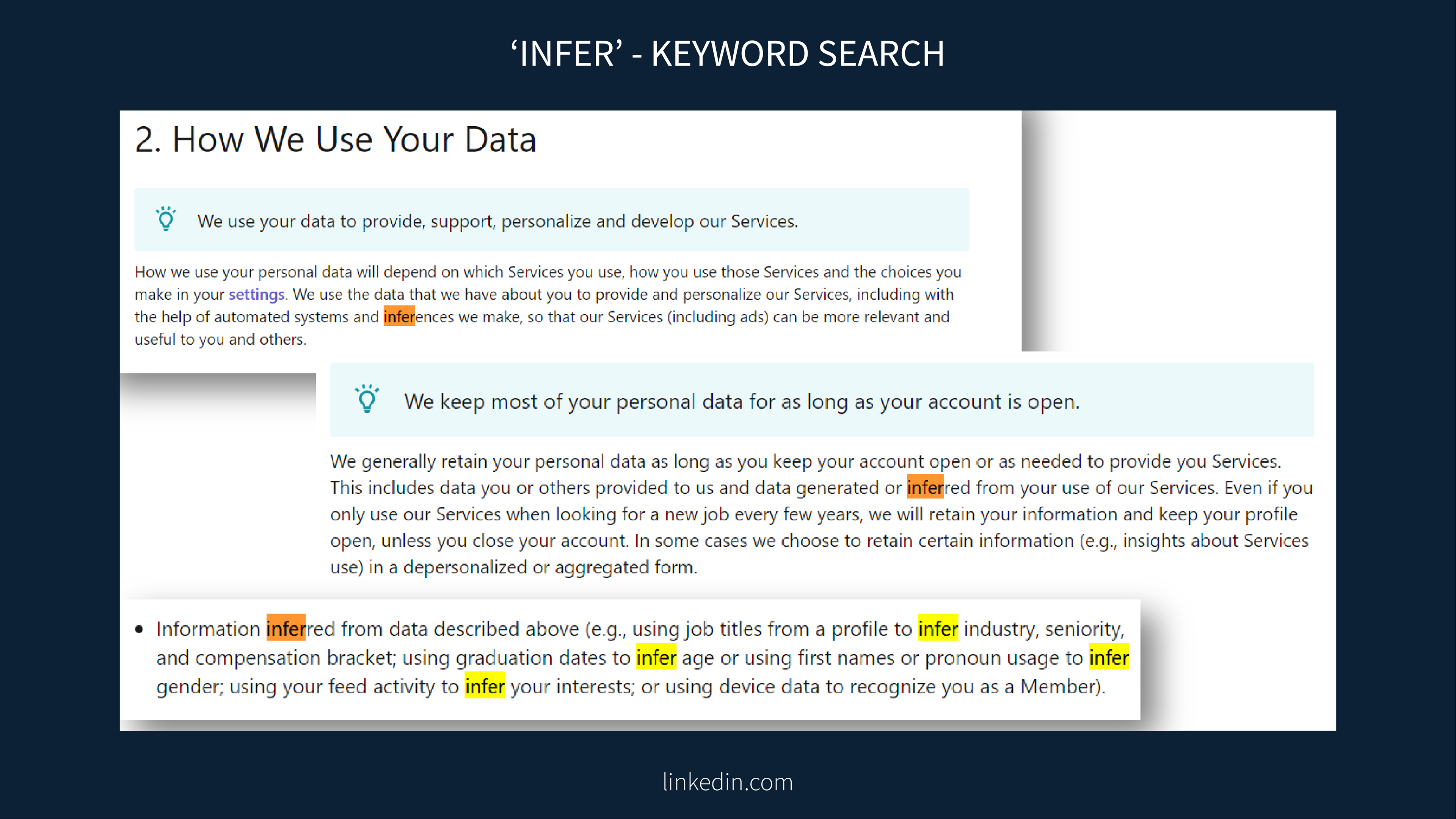
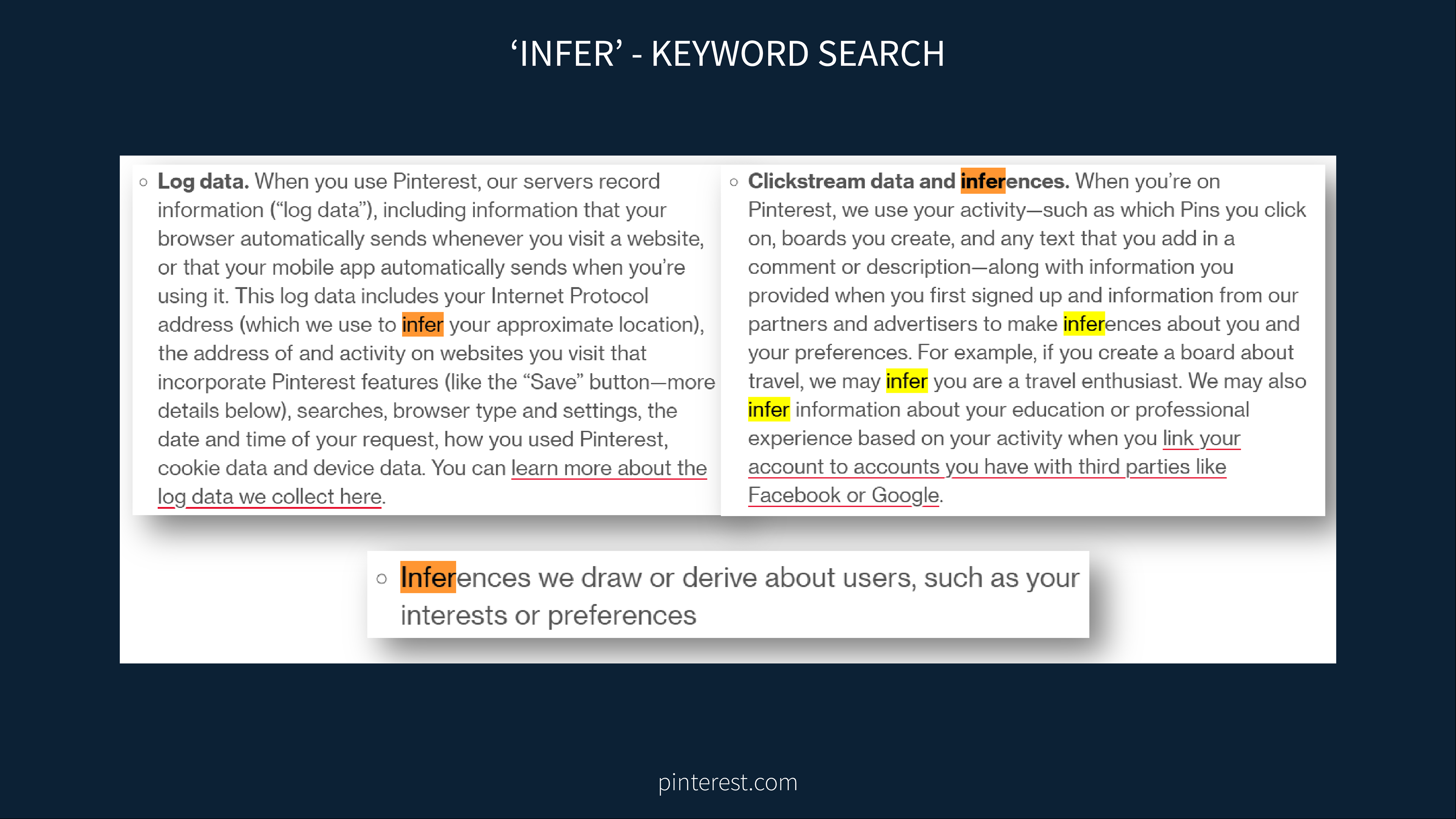
Both these platforms make inferences about users based on their data. When you have access to so much data about someone, it becomes easier to make predictions about them. As Zuboff writes in Surveillance Capitalism, ‘If it’s free you are not the product, but it is the gradual, slight and imperceptible change in your own behavior and perception’. That is the product.
Conclusion:
I started this research in information design, hoping that it would reveal areas of concerns around the use of data in online consent forms, but as the research progressed it moved towards quantitative research and more expansive practices that have repositioned me as an information and communications designer. This research is not solutionist but discursive, that reveals and contests hegemonies in the online realm and leaves it up to the reader to make the final choice.
The problem this research is addressing is complex and of infinite scale, so chances are we might never find a solution to it, but what we could do, is find ways to uncover hidden aspects to mitigate these problems. On the internet, users may have the agency to understand the use of their data, but they are not aware of where to find it and that is where the gap is. Redesigning these systems to fill these gaps will be the first step towards harnessing that agency, which will allow users to control their data and understand how it affects their decisions and that of those around them. Even though information design can help understand concepts of Data Exhaust, Data Mining and Inferences but it does not stop the use of such services. As for designers, this research will assist them in understanding the structures in which they can contribute to future designs and the impact of their participation in social media spaces and help users in understanding True Consent and the impact of their participation in social media spaces.




